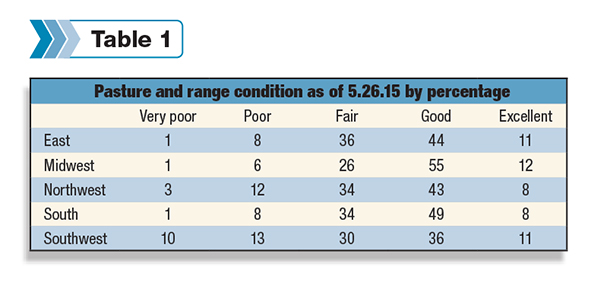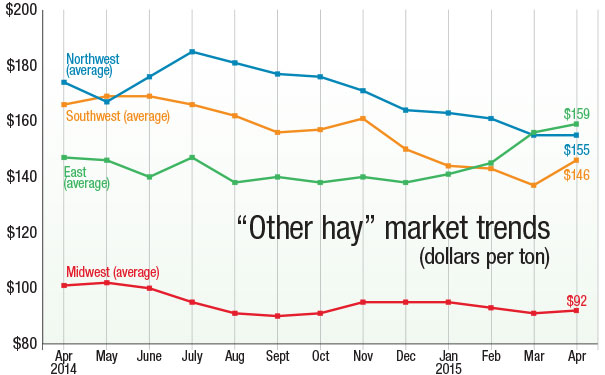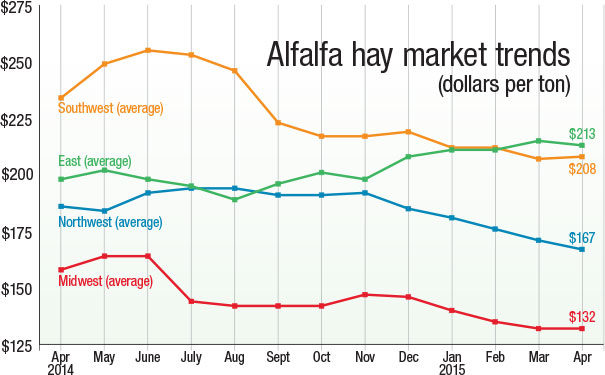Pasture conditions
The USDA National Agricultural Statistics Service (NASS) report of May 26, 2015, on pasture and range conditions of 48 states showed 46 percent in good condition and 32 percent in fair condition. Due to wet spring weather, pastures rating good and excellent are up 11 percent (combined) over last year at this time. Breakdown by region is shown in Table 1.

Weather
Late May brought a very active weather pattern, which led to floods across the central and southern Plains. A heavy rain pushed Oklahoma to its wettest month on record. Showers reached into the lower Mississippi Valley, parts of the upper Midwest and much of the northern Intermountain West, where it caught downed hay in the fields.
Several counties in Arkansas are reported to be under water and still waiting to cut the first hay crop. Corn planting has been delayed in several states, and concerns continue to rise as to whether the soil will dry out enough to get the corn planted this season. Central and southern California, along with southern Florida, has experienced abnormally or excessively dry conditions during the same period. Despite Intermountain showers, the West and Southwest continues with a persistent or intensifying drought three-month outlook.
Dairy report
The USDA reports April milk production is up 1.7 percent from this time last year. March revised production was also up 1.3 percent over last year. Production per cow averaged 1,928 pounds, which is the highest production per cow for the month of April since the series began in 2003. Cow numbers were also up by 2,000 head over March 2015.
The USDA estimated the April 2015 average all-milk price at $16.50 per hundredweight (cwt), down $.10 from March, and $8.80 less than a year ago, reflecting the lowest price since June 2012.
Bob Cropp, professor emeritus at University of Wisconsin – Madison, reports uncertainty in milk pricing through the remainder of the year in his “Dairy Situation and Outlook” of May 19, 2015 (PDF, 62KB). Cropp says, “Dairy exports may not improve as much as earlier anticipated and will stay below year-ago levels.”
The USDA is forecasting milk production to the end the year just 1.3 percent higher than last year. Lower feed prices are conducive to increased milk production.
Other feedstuff commodities
As of May 27, 2015, soybean meal dropped $3, closing at $314.90. Sun-cured alfalfa pellets (15 percent protein) held steady in Kansas City at $210.50 and in Portland at $287.00. Number two yellow corn is well under the market price of a year ago, currently standing at $123.20 (Chicago), $127.84 (Kansas City) and $125.16 (Omaha), compared with $165.07 and above in 2014.
Hay market reports – prices received
Hay markets vary widely by region and by product – alfalfa hay versus “other hay.” The prices and information in Figure 1 (alfalfa hay market trends) and Figure 2 (“other hay” market trends) are provided by NASS and reflect general price trends and movements. Hay quality, however, was not provided in the NASS reports.

For purposes of this report, states that provided data to NASS were divided into the following regions:
Southwest: Arizona, California, Nevada, New Mexico, Oklahoma, Texas
East: Kentucky, New York, Ohio, Pennsylvania
Northwest: Colorado, Idaho, Montana, Oregon, Utah, Washington, Wyoming
Midwest: Illinois, Iowa, Kansas, Michigan, Minnesota, Missouri, Nebraska, North Dakota, South Dakota, Wisconsin FG











